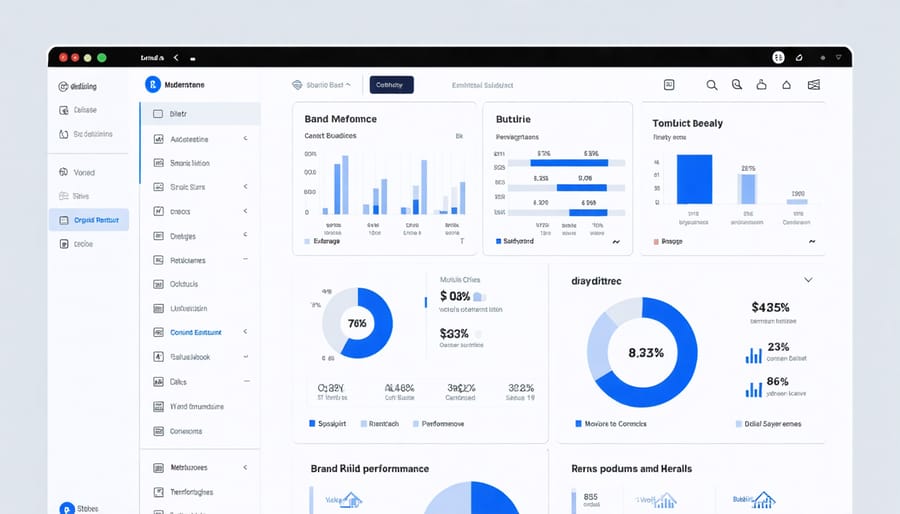Transform your brand’s digital presence by integrating strategic digital marketing tactics with compelling UX-UI design to create lasting market impact. In today’s hyper-connected marketplace, effective brand positioning demands a sophisticated blend of visual storytelling, data-driven decision-making, and authentic community engagement.
Modern branding success hinges on three core pillars: consistent cross-channel messaging that resonates with your target audience, strategic content distribution that maximizes reach while maintaining brand integrity, and meaningful metrics that track both engagement and conversion rates. Small and medium-sized enterprises must particularly focus on developing distinctive brand voices that cut through digital noise while building trust with their local communities.
By aligning your digital branding strategy with measurable business objectives, you create a framework that not only enhances visibility but also drives sustainable growth. This approach ensures every marketing dollar invested contributes directly to strengthening your brand’s market position and fostering genuine connections with your audience.

Building Your Digital Brand Foundation
Defining Your Digital Brand Voice
Your brand voice is the personality and emotion behind your digital presence, serving as the foundation for all your effective digital strategies. To define and maintain a consistent brand voice, start by identifying your core values and target audience’s preferences. Consider how you want your brand to be perceived: professional yet approachable, friendly but authoritative, or innovative while remaining trustworthy.
Create a brand voice chart that outlines three to four key characteristics of your voice, along with specific do’s and don’ts for each trait. For example, if “friendly” is a characteristic, specify using conversational language and personal pronouns while avoiding overly casual slang.
Consistency is crucial across all digital channels. Whether posting on social media, writing blog content, or sending email newsletters, maintain the same tone and personality. Train your team members on these guidelines and create a shared document that includes examples of proper voice usage.
Remember to adapt your voice slightly for different platforms while keeping the core personality intact. LinkedIn may require a more professional tone, while Instagram allows for a more casual approach. Regular content audits help ensure voice consistency and identify areas needing adjustment.
Monitor audience engagement and feedback to refine your voice over time. Your brand voice should evolve with your audience while maintaining its authentic core characteristics.
Visual Brand Elements for Digital Success
Visual branding serves as the cornerstone of your digital marketing presence, creating instant recognition and trust across all platforms. To maintain consistency, start by developing a comprehensive brand style guide that includes your logo specifications, colour palette, typography, and image guidelines.
Your logo should be adaptable for various digital platforms while maintaining its core identity. Create multiple versions optimized for different sizes and backgrounds, ensuring clarity whether it appears on a mobile screen or desktop display. Consider developing a simplified version for favicon and social media profile pictures.
Colour plays a crucial role in brand recognition. Define primary and secondary colour palettes using hex codes, and consistently apply them across your website, social media graphics, and digital advertisements. Typography choices should include web-safe fonts that maintain readability across devices while reflecting your brand personality.
Visual assets like images, icons, and graphics should follow a consistent style that aligns with your brand values. Establish guidelines for photography style, illustration themes, and graphic elements. This includes specifications for image filters, overlay treatments, and compositional approaches.
Remember to maintain appropriate white space and visual hierarchy in all digital materials. Create templates for common content types like social media posts, email newsletters, and blog headers to ensure consistency while saving time in content creation. Regular audits of your visual presence across platforms will help maintain brand cohesion and identify areas needing adjustment.
Digital Channels That Build Brand Authority
Content Marketing for Brand Storytelling
Content marketing serves as a powerful vehicle for brand storytelling, allowing businesses to connect with their audience on a deeper level. By crafting compelling narratives that align with your marketing mix strategy, you can effectively communicate your brand’s values, mission, and unique personality.
Start by identifying your brand’s core story elements – what makes your business unique, what challenges you solve, and how you make a difference in your customers’ lives. This foundation will guide your content creation across all channels, ensuring consistency and authenticity in your messaging.
Consider developing a content calendar that includes blog posts, social media stories, case studies, and video content that showcase your brand’s journey, customer success stories, and behind-the-scenes glimpses of your organization. Each piece should contribute to your larger brand narrative while providing valuable insights to your audience.
Remember to maintain a consistent voice and tone that reflects your brand personality. Whether you’re sharing industry expertise, customer testimonials, or company milestones, ensure your content resonates with your target audience’s needs and interests.
Encourage engagement by inviting your audience to participate in your brand story through user-generated content, community discussions, and interactive content. This two-way dialogue helps build trust and creates a stronger connection with your audience, turning casual readers into brand advocates.
Social Media Brand Building
Each social media platform offers unique opportunities for brand building, and success lies in tailoring your approach to each channel’s strengths. On LinkedIn, focus on sharing professional insights, company culture, and industry expertise to build credibility. Create thought leadership content that resonates with your professional network and showcases your brand’s expertise.
Instagram and TikTok thrive on visual storytelling. Use these platforms to showcase your brand personality through behind-the-scenes content, product demonstrations, and engaging Stories. Develop a consistent visual style that reflects your brand identity, including colour schemes, filters, and graphic elements that make your content instantly recognizable.
Facebook remains valuable for community building and customer engagement. Create and maintain groups related to your industry, host live events, and encourage discussions that position your brand as a community leader. Regular engagement with followers through comments and messages helps humanize your brand and build lasting relationships.
Twitter excels at real-time engagement and customer service. Use it to share timely updates, respond to customer inquiries, and participate in relevant conversations. Develop a distinct brand voice that matches your overall identity while adapting to Twitter’s more casual, conversational nature.
Remember to maintain consistency across all platforms while adapting content format and tone to each platform’s unique environment. Create a content calendar that ensures regular posting while allowing flexibility for timely, relevant updates. Monitor engagement metrics and adjust your strategy based on what resonates with your audience on each platform.

SEO and Brand Visibility
In today’s digital landscape, your brand’s visibility directly impacts its success. Search Engine Optimization (SEO) plays a crucial role in ensuring your brand gets discovered by the right audience at the right time. Start by conducting thorough keyword research focused on terms that align with your brand values and offerings. Incorporate these naturally into your website content, meta descriptions, and image alt tags.
Creating high-quality, relevant content that resonates with your target audience is essential. This includes blog posts, case studies, and industry insights that demonstrate your expertise while addressing your customers’ needs. Ensure your content strategy maintains consistent brand messaging across all platforms.
Local SEO is particularly important for Canadian businesses. Optimize your Google Business Profile, include location-specific keywords, and encourage customer reviews to improve your local search visibility. Build quality backlinks through partnerships with reputable Canadian organizations and industry leaders.
Technical SEO elements like site speed, mobile responsiveness, and secure hosting are crucial for both search rankings and user experience. Regular website audits help identify and fix issues that might affect your brand’s visibility.
Remember to optimize your social media profiles and content for search engines. Use branded hashtags consistently and ensure your profile information aligns with your website’s SEO strategy. Monitor your brand mentions and engage with user-generated content to boost your online presence organically.

Measuring Brand Impact in Digital Marketing
Key Performance Indicators for Brand Success
Measuring your brand’s success in the digital landscape requires tracking specific key performance indicators (KPIs) that align with your business objectives. These metrics provide valuable insights into your brand’s growth, engagement, and overall market position.
Brand awareness can be measured through social media reach, website traffic, and search engine visibility. Monitor your social media follower growth rate, engagement metrics (likes, shares, comments), and brand mention frequency across platforms. Track your website’s organic traffic and the number of branded search queries to understand how well people recognize your brand.
Customer engagement metrics help evaluate how well your audience connects with your brand. Focus on metrics like average time spent on your website, bounce rate, and pages per session. Social media engagement rates and email marketing metrics (open rates, click-through rates) provide additional insight into audience interaction.
Brand sentiment and reputation can be assessed through customer reviews, social media sentiment analysis, and Net Promoter Score (NPS). These indicators help you understand how people perceive your brand and identify areas for improvement.
Conversion-related KPIs demonstrate your brand’s effectiveness in driving business results. Track conversion rates, lead generation metrics, and customer acquisition costs. Also monitor customer lifetime value and retention rates to gauge long-term brand loyalty.
Remember to regularly review these metrics and adjust your strategy based on the insights gained. This data-driven approach ensures your branding efforts remain effective and aligned with your business goals.
Analytics Tools for Brand Monitoring
Effective brand monitoring requires the right digital marketing tools to track your performance and gather meaningful insights. Here are some essential analytics platforms that can help you measure your brand’s digital presence:
Google Analytics remains the foundation of website tracking, offering detailed insights into user behavior, traffic sources, and conversion metrics. It’s particularly valuable for understanding how visitors interact with your brand online.
Social listening tools like Hootsuite and Mention help track brand mentions across social media platforms. These tools provide real-time notifications when someone talks about your brand, allowing for quick response to customer feedback and concerns.
Brand24 and Brandwatch excel at sentiment analysis, helping you understand how people feel about your brand. They monitor conversations across various online channels and provide detailed reports on brand perception.
SEMrush and Ahrefs are invaluable for tracking your brand’s search visibility and monitoring competitors. These platforms offer comprehensive insights into keyword rankings, backlink profiles, and content performance.
For social media analytics, tools like Sprout Social and Buffer Analyze provide detailed metrics about your social media engagement, reach, and audience growth. They help measure the effectiveness of your social media branding efforts and identify areas for improvement.
Remember to regularly review these analytics to adjust your branding strategy and maintain alignment with your business goals.
Brand Crisis Management in the Digital Age
In today’s fast-paced digital landscape, brand reputation can change in an instant. Social media conversations, customer reviews, and online mentions require constant monitoring and strategic management to maintain a positive brand image.
Start by implementing a comprehensive social listening strategy to track brand mentions across all digital platforms. This proactive approach helps identify potential issues before they escalate into full-blown crises. Establish clear communication protocols and response templates for different scenarios, ensuring your team can react quickly and consistently when issues arise.
Create a dedicated crisis management team that includes representatives from marketing, customer service, and leadership. This team should be well-versed in your brand values and authorized to make quick decisions during time-sensitive situations.
Transparency is crucial during crisis management. When mistakes happen, acknowledge them promptly and communicate your plan to address the situation. This builds trust with your audience and demonstrates accountability. Remember to document all crisis responses for future reference and training.
Invest in reputation management tools that help monitor and analyze online sentiment. Regular social media audits and customer feedback analysis can help identify patterns and potential vulnerabilities before they become problems.
Prevention is equally important. Maintain strong relationships with your online community through regular engagement, prompt responses to customer inquiries, and consistent delivery of value. This goodwill serves as a buffer during challenging times and helps maintain brand resilience in the digital space.
Implementing a successful digital branding strategy requires careful planning, consistent execution, and ongoing adaptation to market changes. By following the strategies outlined in this guide, you can build a strong digital brand presence that resonates with your Canadian audience and drives meaningful business results.
Remember that successful digital branding is an ongoing journey rather than a destination. Start by establishing your brand’s core values and voice, then gradually expand your digital footprint across carefully selected channels. Focus on creating authentic connections with your audience through valuable content and engaging community interactions.
Key action steps to begin your digital branding journey include:
– Conducting a thorough brand audit and competitive analysis
– Developing clear brand guidelines and messaging frameworks
– Creating a content calendar that aligns with your brand strategy
– Implementing measurement tools to track brand performance
– Building a responsive community management system
– Regularly reviewing and adjusting your strategy based on data
Most importantly, stay true to your brand’s core values while remaining flexible enough to evolve with changing digital trends. Whether you’re a small business in Toronto or a non-profit in Vancouver, your digital brand should reflect your unique value proposition while meeting the needs of your target audience.
Take the first step today by assessing your current digital presence and identifying areas for improvement. Remember, building a strong digital brand takes time, but the investment will pay dividends in long-term business success and customer loyalty.






